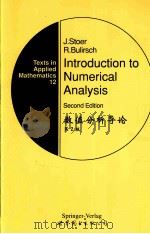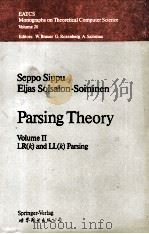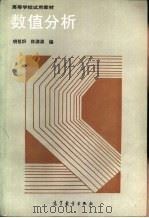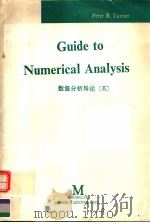《数值分析导论 第2版 英文》
| 作者 | J.Stoer,R.Bulirsch著 编者 |
|---|---|
| 出版 | 世界图书出版公司北京公司 |
| 参考页数 | 661 |
| 出版时间 | 1998(求助前请核对) 目录预览 |
| ISBN号 | 7506233894 — 求助条款 |
| PDF编号 | 81052918(仅供预览,未存储实际文件) |
| 求助格式 | 扫描PDF(若分多册发行,每次仅能受理1册) |

1Error Analysis1
1.1 Representation of Numbers2
1.2 Roundoff Errors and Floating-Point Arithmetic5
1.3 Error Propagation9
1.4 Examples20
1.5 Interval Arithmetic;Statistical Roundoff Estimation27
Exercises for Chapter 133
References for Chapter 136
2Interpolation37
2.1Interpolation by Polynomials38
2.1.1 Theoretical Foundation:The Interpolation Formula of Lagrange38
2.1.2 Neville's Algorithm40
2.1.3 Newton's Interpolation Formula:Divided Differences43
2.1.4 The Error in Polynomial Interpolation49
2.1.5 Hermite Interpolation52
2.2Interpolation by Rational Functions58
2.2.1 General Properties of Rational Interpolation58
2.2.2 Inverse and Reciprocal Differences.Thiele's Continued Fraction63
2.2.3 Algorithms of the Neville Type67
2.2.4 Comparing Rational and Polynomial Interpolations71
2.3Trigonometric Interpolation72
2.3.1 Basic Facts72
2.3.2 Fast Fourier Transforms78
2.3.3 The Algorithms of Goertzel and Reinsch84
2.3.4 The Calculation of Fourier Coefficients.Attenuation Factors88
2.4Interpolation by Spline Functions93
2.4.1 Theoretical Foundations93
2.4.2 Determining Interpolating Cubic Spline Functions97
2.4.3 Convergence Properties of Cubic Spline Functions102
2.4.4 B-Splines107
2.4.5 The Computation of B-Splines110
Exercises for Chapter 2114
References for Chapter 2123
3Topics in Integration125
3.1 The Integration Formulas of Newton and Cotes126
3.2 Peano's Error Representation131
3.3 The Euler-Maclaurin Summation Formula135
3.4 Integrating by Extrapolation139
3.5 About Extrapolation Methods144
3.6 Gaussian Integration Methods150
3.7 Integrals with Singularities160
Exercises for Chapter 3162
References for Chapter 3166
4Systems of Linear Equations167
4.1 Gaussian Elimination.The Triangular Decomposition of a Matrix167
4.2 The Gauss-Jordan Algorithm177
4.3 The Cholesky Decomposition180
4.4 Error Bounds183
4.5 Roundoff-Error Analysis for Gaussian Elimination191
4.6 Roundoff Errors in Solving Triangular Systems196
4.7 Orthogonalization Techniques of Householder and Gram-Schmidt198
4.8Data Fitting205
4.8.1 Linear Least Squares.The Normal Equations207
4.8.2 The Use of Orthogonalization in Solving Linear Least-Squares Problems209
4.8.3 The Condition of the Linear Least-Squares Problem210
4.8.4 Nonlinear Least-Squares Problems217
4.8.5 The Pseudoinverse of a Matrix218
4.9 Modification Techniques for Matrix Decompositions221
4.10 The Simplex Method230
4.11 Phase One of the Simplex Method241
Appendix to Chapter 4245
4.A Elimination Methods for Sparse Matrices245
Exercises for Chapter 4253
References for Chapter 4258
5Finding Zeros and Minimum Points by Iterative Methods260
5.1 The Development of Iterative Methods261
5.2 General Convergence Theorems264
5.3 The Convergence of Newton's Method in Several Variables269
5.4A Modified Newton Method272
5.4.1 On the Convergence of Minimization Methods273
5.4.2 Application of the Convergence Criteria to the Modified Newton Method278
5.4.3 Suggestions for a Practical Implementation of the Modified Newton Method.A Rank-One Method Due to Broyden282
5.5 Roots of Polynomials.Application of Newton's Method286
5.6 Sturm Sequences and Bisection Methods297
5.7 Bairstow's Method301
5.8 The Sensitivity of Polynomial Roots303
5.9 Interpolation Methods for Determining Roots306
5.10 The △2-Method of Aitken312
5.11 Minimization Problems without Constraints316
Exercises for Chapter 5325
References for Chapter 5328
6Eigenvalue Problems330
6.0 Introduction330
6.1 Basic Facts on Eigenvalues332
6.2 The Jordan Normal Form of a Matrix335
6.3 The Frobenius Normal Form of a Matrix340
6.4 The Schur Normal Form of a Matrix;Hermitian and Normal Matrices;Singular Values of Matrices345
6.5Reduction of Matrices to Simpler Form351
6.5.1 Reduction of a Hermitian Matrix to Tridiagonal Form:The Method of Householder353
6.5.2 Reduction of a Hermitian Matrix to Tridiagonal or Diagonal Form:The Methods of Givens and Jacobi358
6.5.3 Reduction of a Hermitian Matrix to Tridiagonal Form:The Method of Lanczos362
6.5.4 Reduction to Hessenberg Form366
6.6Methods for Determining the Eigenvalues and Eigenvectors370
6.6.1 Computation of the Eigenvalues of a Hermitian Tridiagonal Matrix370
6.6.2 Computation of the Eigenvalues of a Hessenberg Matrix.The Method of Hyman372
6.6.3 Simple Vector Iteration and Inverse Iteration of Wielandt373
6.6.4 The LR and QR Methods380
6.6.5 The Practical Implementation of the QR Method389
6.7 Computation of the Singular Values of a Matrix400
6.8 Generalized Eigenvalue Problems405
6.9 Estimation of Eigenvalues406
Exercises for Chapter 6419
References for Chapter 6425
7Ordinary Differential Equations428
7.0 Introduction428
7.1 Some Theorems from the Theory of Ordinary Differential Equations430
7.2Initial-Value Problems434
7.2.1 One-Step Methods:Basic Concepts434
7.2.2 Convergence of One-Step Methods439
7.2.3 Asymptotic Expansions for the Global Discretization Error of One-Step Methods443
7.2.4 The Influence of Rounding Errors in One-Step Methods445
7.2.5 Practical Implementation of One-Step Methods448
7.2.6 Multistep Methods:Examples455
7.2.7 General Multistep Methods458
7.2.8 An Example of Divergence461
7.2.9 Linear Difference Equations464
7.2.10 Convergence of Multistep Methods467
7.2.11 Linear Multistep Methods471
7.2.12 Asymptotic Expansions of the Global Discretization Error for Linear Multistep Methods476
7.2.13 Practical Implementation of Multistep Methods481
7.2.14 ExtrapolationMethodsfortheSolutionoftheInitial-ValueProblem484
7.2.15 Comparison of Methods for Solving Initial-Value Problems487
7.2.16 Stiff Differential Equations488
7.2.17 Implicit Differential Equations.Differential-Algebraic Equations494
7.3Boundary-Value Problems499
7.3.0 Introduction499
7.3.1 The Simple Shooting Method502
7.3.2 The Simple Shooting Method for Linear Boundary-Value Problems507
7.3.3 An Existence and Uniqueness Theorem for the Solution of Boundary-Value Problems509
7.3.4 Difficulties in the Execution of the Simple Shooting Method511
7.3.5 The Multiple Shooting Method516
7.3.6 Hints for the Practical Implementation of the Multiple Shooting Method520
7.3.7 An Example:Optimal Control Program for a Lifting Reentry Space Vehicle524
7.3.8 The Limiting Case m→∞ of the Multiple Shooting Method(General Newton's Method,Quasilinearization) 531
7.4 Difference Methods535
7.5 Variational Methods540
7.6 Comparison of the Methods for Solving Boundary-Value Problems for Ordinary Differential Equations549
7.7 Variational Methods for Partial Differential Equations.The Finite-Element Method553
Exercises for Chapter 7560
References for Chapter 7566
8Iterative Methods for the Solution of Large Systems of Linear Equations.Some Further Methods570
8.0 Introduction570
8.1 General Procedures for the Construction of Iterative Methods571
8.2 Convergence Theorems574
8.3 Relaxation Methods579
8.4 Applications to Difference Methods—An Example588
8.5 Block Iterative Methods594
8.6 The ADI-Method of Peaceman and Rachford597
8.7 The Conjugate-Gradient Method of Hestenes and Stiefel606
8.8 The Algorithm of Buneman for the Solution of the Discretized Poisson Equation614
8.9 Multigrid Methods622
8.10 Comparison of Iterative Methods632
Exercises for Chapter 8636
References for Chapter 8643
General Literature on Numerical Methods646
Index648
1998《数值分析导论 第2版 英文》由于是年代较久的资料都绝版了,几乎不可能购买到实物。如果大家为了学习确实需要,可向博主求助其电子版PDF文件(由J.Stoer,R.Bulirsch著 1998 世界图书出版公司北京公司 出版的版本) 。对合法合规的求助,我会当即受理并将下载地址发送给你。
高度相关资料
-

- 数值分析引论
- 1998 杭州:浙江大学出版社
-

- 数值分析
- 1992
-

- 数值分析
- 1998
-

- 分析理论 第2卷 英文版
- 1990 Springer-Verlag
-

- 数值分析
- 1990 昆明:云南大学出版社
-

- 塑性理论简明教程
- 1981 北京:清华大学出版社
-

- 数值分析
- 1986 北京:高等教育出版社
-

- 半导体数值分析
- 1986 上海:上海翻译出版公司
-

- 热传导及其数值分析
- 1981 北京:清华大学出版社
-

- 数值分析
- 1958 北京:科学出版社
-

- 数值分析
- 1998 厦门:厦门大学出版社
-

- 集值测度与随机集
- 1989 西安:西安交通大学出版社
-

- 数值分析引论
- 1995 南京:南京大学出版社
提示:百度云已更名为百度网盘(百度盘),天翼云盘、微盘下载地址……暂未提供。➥ PDF文字可复制化或转WORD

